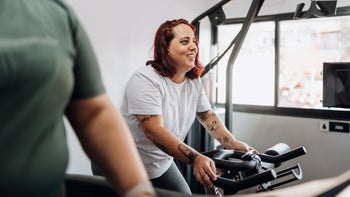
5 Agility Exercises for Better Balance, Mobility, and Fitness
Key takeaways:
Agility is a skill that allows you to move your body efficiently, changing direction or speed with precision.
Agility training may improve balance, strength, and exercise performance. It can benefit people of various fitness levels, from beginners to athletes.
Examples of agility exercises include toe taps, high knees, and skater jumps.

Most people focus on cardio and strength training when creating a workout routine. Both are essential for your health and fitness. But other methods, such as agility training, can help round out your fitness plan.
Agility is a skill-related aspect of your fitness. It is the ability to rapidly and precisely change direction or speed when you move. Athletes who play tennis, basketball, and soccer exhibit agility as they move on the court or field.
But agility training isn't just for athletes who play competitive sports. Agility exercises challenge you to move your body in multiple directions. And they may improve functional fitness and exercise performance. So beginners, recreational athletes, and everyone in between can get something out of this type of training.
Search and compare options
Exercises and activities that build agility
Agility training can help you develop critical skills for your workouts and everyday life. Multi-directional movements make you think and react quickly. At the same time, you’re working your muscles to build strength, improve balance, and increase speed.
There are numerous beginner-friendly and advanced agility exercises to try.
1. Alternating toe taps
Alternating toe taps engage your core and lower-body muscles, including the glutes and quadriceps. All you need is a sturdy aerobic step or Bosu ball.
Step 1: Stand tall in front of an exercise step. Put the ball of your right foot on the step and keep your left foot flat on the floor.
Step 2: Press through your left foot to switch your legs, tapping your left foot on the step as you place your right foot flat on the floor.
Step 3: Continue alternating toe taps, swinging your arms like you would while running. Move as quickly as you can, and try to be precise when tapping the ball of each foot. Imagine a target on the top of the Bosu ball or box.
Step 4: Keep moving for 30 seconds. Then gradually build up to 60 seconds or more.
2. Side-to-side hops
This agility drill can improve hip strength and stability. Side-to-side hops are an example of lateral training, which may help prevent muscle imbalances. You'll need a jump rope, exercise band, or other tool that will be a marker on the floor.
Step 1: Stand up straight with a jump rope on the floor. You should be standing parallel to the jump rope.
Step 2: Keep your feet together as you hop over the line and back again as fast as you can.
Step 3: Continue hopping side to side for 30 seconds. If you notice that your feet land in a different position with each hop, slow down and focus on your form.
Advanced athletes can do single-leg hops. This variation requires more balance, muscular strength, and core activation. You can hop over a cone or low barrier as you get stronger.
Read more like this
Explore these related articles, suggested for readers like you.
3. High knees
The high knees exercise is a great way to boost your heart rate and improve your foot turnover for activities like sprinting. It engages lower-body muscles, including the glutes, quads, and calves.
Step 1: Stand tall with your arms at your sides and your feet hip-width apart.
Step 2: Engage your core and swing your arms as you drive your right knee toward your chest.
Step 3: Quickly switch legs, bringing your left knee toward your chest and your right foot flat on the floor. Try to land on each foot as you sprint in place. Remember to use your arms for momentum when you drive your knee to your chest.
Step 4: Keep alternating legs for 30 to 60 seconds. Imagine making an exaggerated sprinting motion with a high-knee drive.
4. Bear crawls
The bear crawl is an excellent addition to an agility training program. The advanced full-body move works the arms, back, core, and legs.
Step 1: Begin in a push-up position with your hands under your shoulders, feet hip-width apart, and toes touching the floor. Keep your back straight and engage your core.
Step 2: Press into your left foot as you squeeze your right glute and thigh muscles. Move your right foot and left hand forward in a crawling motion.
Step 3: Switch sides, moving your left foot and right hand forward.
Step 4: Continue alternating, crawling forward for your desired distance.
And once you master the bear crawl, you can try different variations, crawling backward or to the side for a desired distance.
5. Skater jumps
Like side-to-side hops, the skater jump is a lateral agility exercise. The heart-pumping move can help build lower-body muscle strength and endurance.
Step 1: Stand up straight with your arms at your sides, feet shoulder-width apart, and knees slightly bent.
Step 2: Shift your weight to the right side and cross your left leg behind your right, landing on the ball of your left foot.
Step 3: Lean forward, bending slightly at the hips. Push through your right foot as you jump to the left, landing on your left foot.
Step 4: Let your right leg swing behind your left, tapping your toes on the floor. Experienced athletes can skip the toe tap, leaving their back leg in the air for an advanced skater jump.
Step 5: Jump to the right and land on your right foot to reverse the movement and complete one rep.
Step 6: Complete 2 to 3 sets of 8 to 10 reps.
What are the benefits of agility training?
The top benefits of agility exercises make them a worthwhile addition to your fitness plan.
Builds muscle power and strength
Agility exercises include dynamic compound movements that work multiple muscle groups at the same time. So they're a great way to increase muscle power. In fact, a 2020 study found that agility exercises helped older adults improve muscle power and strength.
Muscle power allows you to exert the force you need for explosive movements like jumping or throwing a ball.
Helps with balance and coordination
Anyone who has practiced agility drills will tell you that they challenge you in many ways. Many of the movements require you to start, stop, and change directions quickly while you remain steady on your feet.
Those activities can help your proprioception, or awareness of your body and how you move. That may lead to better dynamic balance and coordination for people of all ages, including children and older adults.
Improves functional fitness and athletic performance
Agility exercises involve quick, multi-directional movements. And many of them include explosive jumping that makes them double as plyometric moves. They can help you increase speed and overall athletic performance.
Agility training can also help you work on functional fitness for your everyday life. It's been shown to help older adults improve their gait and walking speed.
Lowers the risk of injury
Practicing agility exercises may reduce the risk of falls and other injuries. That's not surprising, with so many potential improvements for your mobility and exercise performance.
Tips for practicing agility exercises safely
Agility exercises are generally safe for people of different fitness levels. But talk to your healthcare provider before starting an agility training program, especially if you have health conditions that may affect your performance. And remember these tips to help you get started.
Start gradually
Anytime you incorporate a new type of training into your fitness routine, you should build up slowly. Begin with just one or two agility exercises once or twice a week. Agility training can be tiring for the neuromuscular system because it requires a lot of coordination. A gradual progression can help prevent overtraining, falls, and other injuries.
Find the right footwear
Make sure that you wear supportive shoes for agility training. They should be comfortable with good tread to prevent slipping. Cross-training shoes are ideal because they provide more lateral stability than running or walking shoes.
Focus on your form
Beginners should focus on technique. Although agility exercises aim to increase speed and reaction time, you have to learn proper form before you worry about speed.
Check your surroundings
Scan the area where you plan to practice agility exercises. You'll change directions often, and any obstacles might slow you down or make you fall. Pick up any loose objects before you start your workout.
The bottom line
Agility exercises may improve reaction time, muscle strength, and balance. And you don't have to be an athlete to benefit. People of all ages and fitness levels can work on their agility. Adding a few moves to your weekly routine could lead to better functional and athletic fitness.
Why trust our experts?



References
American Council on Exercise. (n.d.). Bear crawl exercise.
Beato, M., et al. (2018). Effects of plyometric and directional training on speed and jump performance in elite youth soccer players. Journal of Strength and Conditioning Research.
Bohrer, R. C. D., et al. (2019). Multicomponent training program with high-speed movement execution of ankle muscles reduces risk of falls in older adults. Rejuvenation Research.
Booth, M. A., et al. (2016). Effects of plyometric training on sports performance. Strength and Conditioning Journal.
DARBEE. (2015). Exercise library: Side-to-side hops [video]. Youtube.
DrDavePac. (2022). Line hops [video]. Youtube.
Elevated Fitness. (2021). Step toe taps [video]. Youtube.
Even, W. P., et al. (2010). Evaluating plyometric exercises using time to stabilization. Journal of Strength and Conditioning Research.
FitnessBlender. (2010). High knees (Lv 2) [video]. Youtube.
FitnessBlender. (2010). Lateral jumps (lv 2) [video]. Youtube.
Lichtenstein, E., et al. (2020). Agility-based exercise training compared to traditional strength and balance training in older adults: A pilot randomized trial. PeerJ.
Morat, M., et al. (2021). Effects of multimodal agility-like exercise training compared to inactive controls and alternative training on physical performance in older adults: A systematic review and meta-analysis. European Review of Aging and Physical Activity.
ScienceDirect. (n.d.). Agility.
Sharpie, M. N. M. (2018). A case study: The effects of speed, agility and quickness (SAQ) training program on hand-eye coordination and dynamic balance among children. Journal of Physical Fitness, Medicine, & Treatment in Sports.
Sporiš, G., et al. (2010). The effect of agility training on athletic power performance. Hrčak.
Wolf, R., et al. (2020). Multicomponent exercise training improves gait ability of older women rather than strength training: A randomized controlled trial. Journal of Aging Research.




























